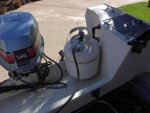A
Anonymous
Guest
As part of my re-fitting project, I'm looking at adding a propane fuel system for cooking and cabin heating. I'm a little confused regarding where propane tanks can be safely stored. Understanding that propane is heavier than air and can collect in bilges, I'm wondering if I should have any concern about tank storage in the cockpit. Is there enough air movement - even when the air is quite still - to eliminate build-up of propane in the cockpit?
As an alternative to cockpit storage, I'm considering a 'hayrack', a la Redfox, for additional storage; perhaps a propane tank might be mounted to one of the vertical supports (which will also help counterbalance house batteries) which would vent overboard for the most part. At least I guess it would vent overboard, but that might depend on the prevailing wind.
I hope I'm being overconcerned, but I'd hate to blow up. I've seen a boat blow up once. Not pretty.
Advice???
Thanks,
Tom Herrick
As an alternative to cockpit storage, I'm considering a 'hayrack', a la Redfox, for additional storage; perhaps a propane tank might be mounted to one of the vertical supports (which will also help counterbalance house batteries) which would vent overboard for the most part. At least I guess it would vent overboard, but that might depend on the prevailing wind.
I hope I'm being overconcerned, but I'd hate to blow up. I've seen a boat blow up once. Not pretty.
Advice???
Thanks,
Tom Herrick

